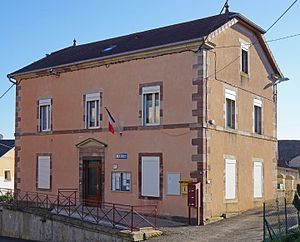Ailloncourt
| Ailloncourt | ||
|---|---|---|
|
|
||
| region | Bourgogne-Franche-Comté | |
| Department | Haute-Saône | |
| Arrondissement | Lure | |
| Canton | Luxeuil-les-Bains | |
| Community association | Triangle Vert | |
| Coordinates | 47 ° 45 ' N , 6 ° 23' E | |
| height | 264-450 m | |
| surface | 9.29 km 2 | |
| Residents | 302 (January 1, 2017) | |
| Population density | 33 inhabitants / km 2 | |
| Post Code | 70300 | |
| INSEE code | 70007 | |
 Mairie Ailloncourt |
||
Ailloncourt is a municipality in the French department of Haute-Saône in the region Bourgogne Franche-Comté .
geography
Ailloncourt is located at an altitude of 282 m above sea level, seven kilometers south of Luxeuil-les-Bains and about 23 kilometers northeast of the city of Vesoul (as the crow flies). The village extends in the northern part of the department, on the southern edge of the Luxeuil plain, on the Lanterne .
The area of the 9.29 km² municipal area includes a section of the Luxeuil plain. The main part of the area is taken up by this alluvial plain , which averages 275 m. The most important watercourse is the Lanterne, which crosses the area from east to west and provides drainage to the Saône . At Ailloncourt it takes the Ruisseau de Perchie from the left . Agricultural use predominates at this level.
To the northeast, the area extends with a narrow tip over the plain into the vast forests of Grand Bois and Vay de Brest . There are several ponds here, most of which have been dammed and are used for fish farming, including the Grand Étang . To the southwest of the village, the terrain rises very slowly to a plateau made of shell limestone from the Middle Triassic . In the far south-west a step leads to the wooded plateau of Mont d'Ahie , on which the highest point of Ailloncourt is reached at 450 m. This height is made up of alternating layers of calcareous and sandy-marl sediments that were deposited during the Lias ( Lower Jurassic ).
Neighboring municipalities of Ailloncourt are La Chapelle-lès-Luxeuil and Esboz-Brest in the north, Citers in the east, Dambenoît-lès-Colombe , Genevrey and Betoncourt-lès-Brotte in the south and Brotte-lès-Luxeuil in the west.
history
The area around Ailloncourt was inhabited very early, as evidenced by the remains of a Gallo-Roman settlement. Ailloncourt is first mentioned in 1144. In the Middle Ages, Ailloncourt belonged to the Free County of Burgundy and in it to the area of the Bailliage d'Amont . The lords of Luxeuil held local rule. Together with Franche-Comté, the village finally came to France with the Peace of Nijmegen in 1678. Today Ailloncourt is a member of the community association Communauté de communes des Franches-Communes, which comprises 14 localities .
Attractions
Ailloncourt was rebuilt in the 18th century. The remarkable furnishings include a statue of the Madonna from the 17th century as well as altars, pulpit and statuettes from the 18th century.
The town center is characterized by various houses from the 18th and 19th centuries, which show the traditional style of the Haute-Saône. Other attractions include a former water mill, a large semicircular fountain and several calvaries .
population
| Population development | |
|---|---|
| year | Residents |
| 1962 | 215 |
| 1968 | 198 |
| 1975 | 151 |
| 1982 | 223 |
| 1990 | 225 |
| 1999 | 224 |
| 2006 | 281 |
With 302 inhabitants (January 1, 2017), Ailloncourt is one of the small communities in the Haute-Saône department. After the population had decreased significantly in the first half of the 20th century (405 people were counted in 1881), the population has continued to grow steadily since the mid-1970s.
Economy and Infrastructure
Until well into the 20th century, Ailloncourt was mainly characterized by agriculture (arable farming, fruit growing and cattle breeding), forestry and fish farming. Today there are some local small businesses. In the last few decades the village has transformed into a residential community. Many workers are therefore commuters who work in the larger towns in the area.
The village is located off the major thoroughfares on a department road that leads from Citers to Brotte-lès-Luxeuil. There are other road connections with Saint-Sauveur and Dambenoît.



